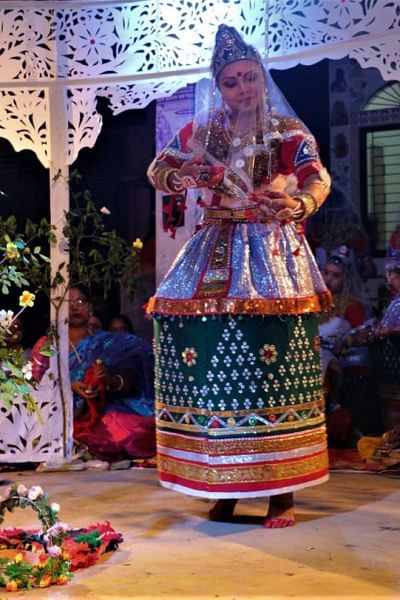The Manipuri Raas Leela: Where performance meets history and mythology

The Raas Leela is an important part of Manipuri culture. The term roughly means 'dance of divine love and passion'. Dancers symbolise their spiritual love for Lord Krishna when they perform the Raas Leela. At 76, Krishnakumari Sinha is one of the most renowned artistes of this traditional art form in Bangladesh. For more than three decades, she has also been a guru to many. In a conversation with The Daily Star, Krishnakumari Sinha, along with her two disciples Sharmila Sinha and Jyoti Sinha, talk about the Manipuri Raas Leela, and their journey with it.
At 18, Krishnakumari Sinha became the first singer to participate in traditional, Manipuri performances. Till date, she has sung in more than 300 Manipuri Raas Leelas as the Sutradhari or the main narrator, including her own region in Kamalgonj, Sylhet and India's Assam,Tripura. Besides, she has participated in more than a hundred Raas Leelas as a dancer. She has conducted close to 30 Raas Leelas.

She also conducted experimental work on other Manipuri performances. "I began as a singer. Eventually I learnt the dance and began to direct my own versions of the Raas Leela," she recalled. The journey was not easy; she had to prove her diligence to her masters for approval. "I was married off at a tender age. However, I had the opportunity to learn from four gurus, and acquire knowledge of Raas Leela," said Krishnakumari Sinha. According to her, the gurus hold an important position in the propagation of the art form.
Sharmila Sinha, one of her students, is a vocalist at Manipuri Theatre and a lecturer at Adbul Gaffar Chowdhury Mohila Collegein Kamalgonj. She said, "Natsankirtan is the main part of our culture and Guruvandana is sung immediately after Gauravandana. The concept of Guru-Shishya Parampara is an integral part of the cultural concept."

Sharmila began training with Krishnakumari at a young age. "I grew up hearing and watching the masters Krishnakumari Sinha and Thoibi Debi. I watched their brilliant performances in Raas Leela, Nupipala, Khubakoishi. Krishnakumari Sinha is also a friend of my mother. I expressed my aspiration of receiving her mentorship and she accepted me with open arms," she added.
Raas Leela or Natpala combines melody with some of the hardest rhythm and tempo of the Mridangam, creating a transcending experience. It is also rich in theatrical quality. From a cultural context, the costume also carries important essences of the art form. The costume of the Manipuri Raas Leela consists of an embroidered stiff skirt and a light muslin garment on top with a white veil and traditional Manipuri jewelry.

"Raas Leela showcases a worldly and transcendental relationship between living beings, a philosophy of spiritualism and materialism that is served with dance and songs through the narration of Radha Krishna's love," explained Sharmila. "It is this cultural milieu with a deep philosophical sense of life that may help to shape the mindset of the Manipuri people, teaching them modesty and morality. Subsequently, it is an important subject of research."
Jyoti Sinha, a brilliant theatre actor and dancer also began her training with Krishnakumari Sinha at a young age. To gain mentorship, the guru is offered a plate of Khoi, which are small tokens through which a disciple is accepted. Jyoti not only learnt the songs but also picked up the dance form. "The main concept of the dance is Bhakti or devotion. The tenderness of the gestures reflects the passion and love between Radha and Krishna, denoting the Jivatma and Paramatma. My guru not only taught me the artistic form but also enlightened me with a philosophy that helps me in my practice and way of life," she explained.
Both Sharmila and Jyoti are also teachers to many young students. However, their mode of practice has changed a bit, over time. "The use of harmonium is absent in Manipuri music; however, when I teach my students for various theatre productions, I use the instrument to be precise to the Manipuri notes and their practice," says Sharmila. Jyoti, on the other hand, tries to impart teachings that are similar to ones she was taught. "I try to bridge the gap between the aesthetics of the art form with its concepts," she said.
The traditional art form is still being practiced in Manipuri Theater, Manipuri Lalitkala Academy, Dhrumela, Poiri and some other institutions, where regular workshops, classes and trainings are conducted. Different types of Manipuri Raas Leelas like Vasanta Raas, Maha Raas, Nitya Raas, Kunja Raas and Diba Raas, are regularly performed for the public. Rakhal Raas is only performed by men.
Krishnakumari Sinha dedicated her life to the Manipuri Raas Leela. However, her students have been involved in different forms as well. "I have picked up knowledge of different forms, but I am yet to master them. Besides, we go nowhere close to our gurus when it comes to the depth of dedication. I still have miles to go," Sharmila said. Krishnakumari Sinha, on the other hand, feels truly proud of her two students.
She said, "Sharmila and Jyoti are two of my brightest students. They learn with great endurance, and are doing a wonderful job in performing and propagating the art form. They will be the torchbearers of my teachings."
The author is an art researcher and writer in the making. Email: [email protected].

 For all latest news, follow The Daily Star's Google News channel.
For all latest news, follow The Daily Star's Google News channel. 



Comments